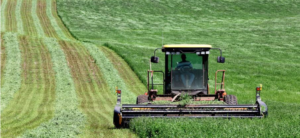 Rhizoma Peanut Hay for Horses: When horsemen think of legume hay, alfalfa invariably springs to mind with clover or lespedeza as possible runners-up. Few people probably think of rhizoma peanut (Arachis glabrata Benth), a warm-season perennial legume. While rhizoma peanut gets high marks for productivity and persistence in varying management and environmental conditions, how does it stack up nutritionally against alfalfa, the long-revered gold standard of legumes for horses?
Rhizoma Peanut Hay for Horses: When horsemen think of legume hay, alfalfa invariably springs to mind with clover or lespedeza as possible runners-up. Few people probably think of rhizoma peanut (Arachis glabrata Benth), a warm-season perennial legume. While rhizoma peanut gets high marks for productivity and persistence in varying management and environmental conditions, how does it stack up nutritionally against alfalfa, the long-revered gold standard of legumes for horses?
Researchers at the University of Florida intended to find out by comparing rhizoma peanut with alfalfa and bermudagrass in terms of nutrient intake, apparent digestibility, and nitrogen balance in mature horses at maintenance.*
Quarter Horse geldings were assigned randomly to one of the three hay treatments for three 21-day experimental periods. Each experimental period consisted of a 14-day adaptation period followed by three days of total fecal and urine collection, and then a four-day rest. During each period, horses were fed a particular hay at 2% of body weight per day in three meals. Consequently, researchers collected core samples of all hays to determine nutrient composition.
The researchers concluded that “rhizoma peanut is a high-quality legume hay providing nutrient intake and digestibility intermediate between alfalfa and bermudagrass. For example, the nutrients provided by rhizoma peanut hay meet the nutritional needs of horses at maintenance, while resulting in less nitrogen excretion than alfalfa.” However, in light of environmental concerns centering around nitrogen, horse owners may choose to feed rhizoma peanut hay when available and appropriate for the intended horses.
Key points concerning rhizoma peanut hay include:
Rhizoma peanut hay should not be confused with “peanut hay” or annual peanut hay, which is made from the plants that remain after peanut harvest. Therefore, hay made from annual peanuts is unsuitable for horses, as it is usually sandy, dusty, stemmy, and low in nutritional value.**
As a warm-season perennial, rhizoma peanut hay tends to grow well in areas in which alfalfa does not.
Similarly, horses find rhizoma peanut hay as palatable as alfalfa. In one study horses preferred rhizoma peanut hay to alfalfa hay, potentially because the horses favored the finer stems of the rhizoma peanut.+
Rhizoma peanut is often used like alfalfa, as a source of supplemental calories. Subsequently, because of its palatability, overconsumption may result in excess body condition in easy keepers.
While all-forage diets are appropriate for many horses, forages do not provide a complete complement of nutrients needed for optimal health. Above all, horses on all-forage diets should be supplemented with a high-quality vitamin and mineral product.
In conclusion, do you have questions about Rhizoma Peanut Hay? Contact us at J & J Hay Farms by clicking here!
Resources:
Article by: Kentucky Equine Research
In addition:
*Vasco, A.C.C.M., K.J. Brinkley-Bissinger, J.M. Bobel, J.C.B. Dubeaux Jr., L.K. Warren, and C.L. Wickens. 2021. Digestibility and nitrogen and water balance in horses fed rhizoma peanut hay. Journal of Animal Science 99(11):1-9.
**Hill, G.M. 2002. Peanut by-products fed to cattle. Veterinary Clinics of North America: Food Animal Practice 18:295-315.
+Lieb, S., E.A. Ott, and E.C. French. 1993. Digestible nutrients and voluntary intake of rhizomal peanut hay, alfalfa, bermudagrass, and bahiagrass hays by equine. In: Proc. 13th Equine Nutrition and Physiology Society, Gainesville, p. 98.
